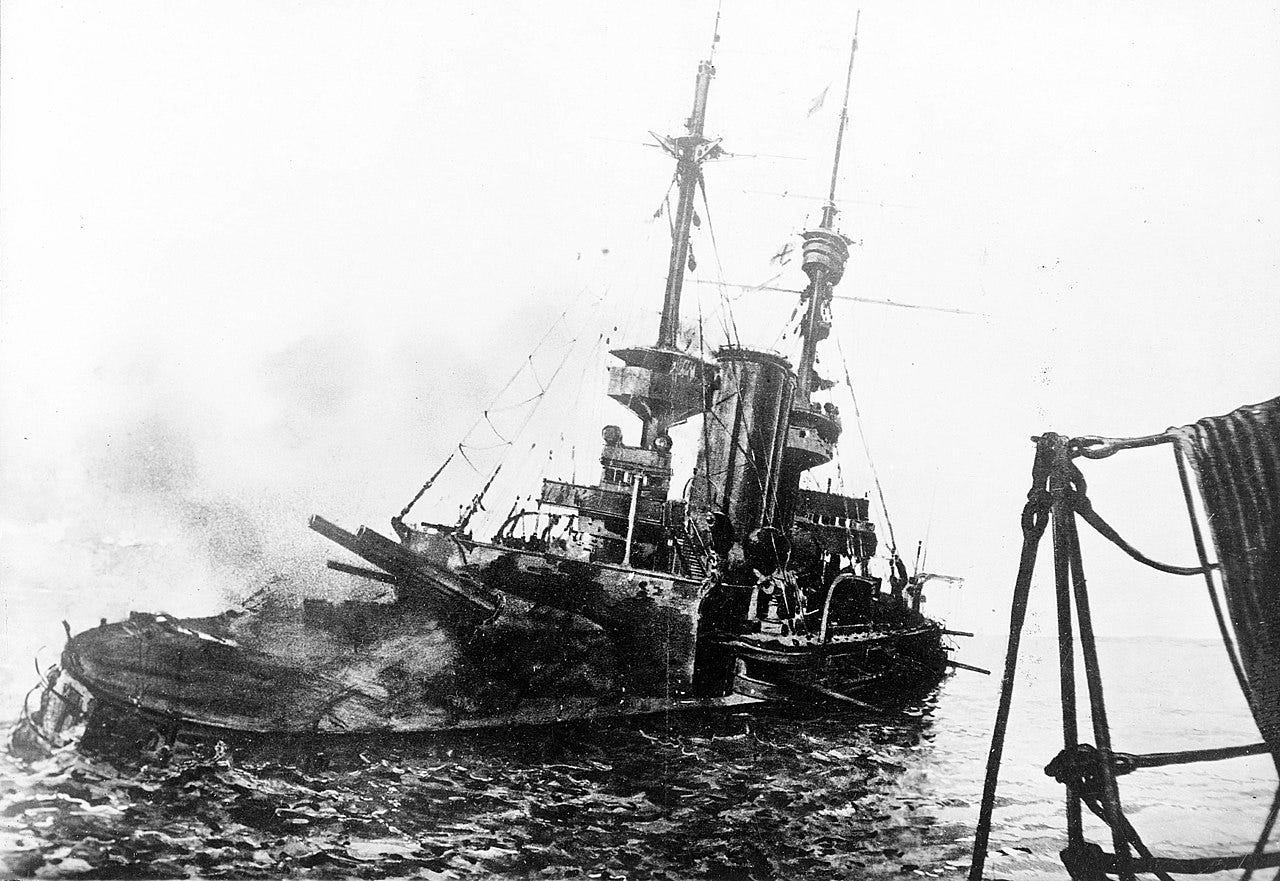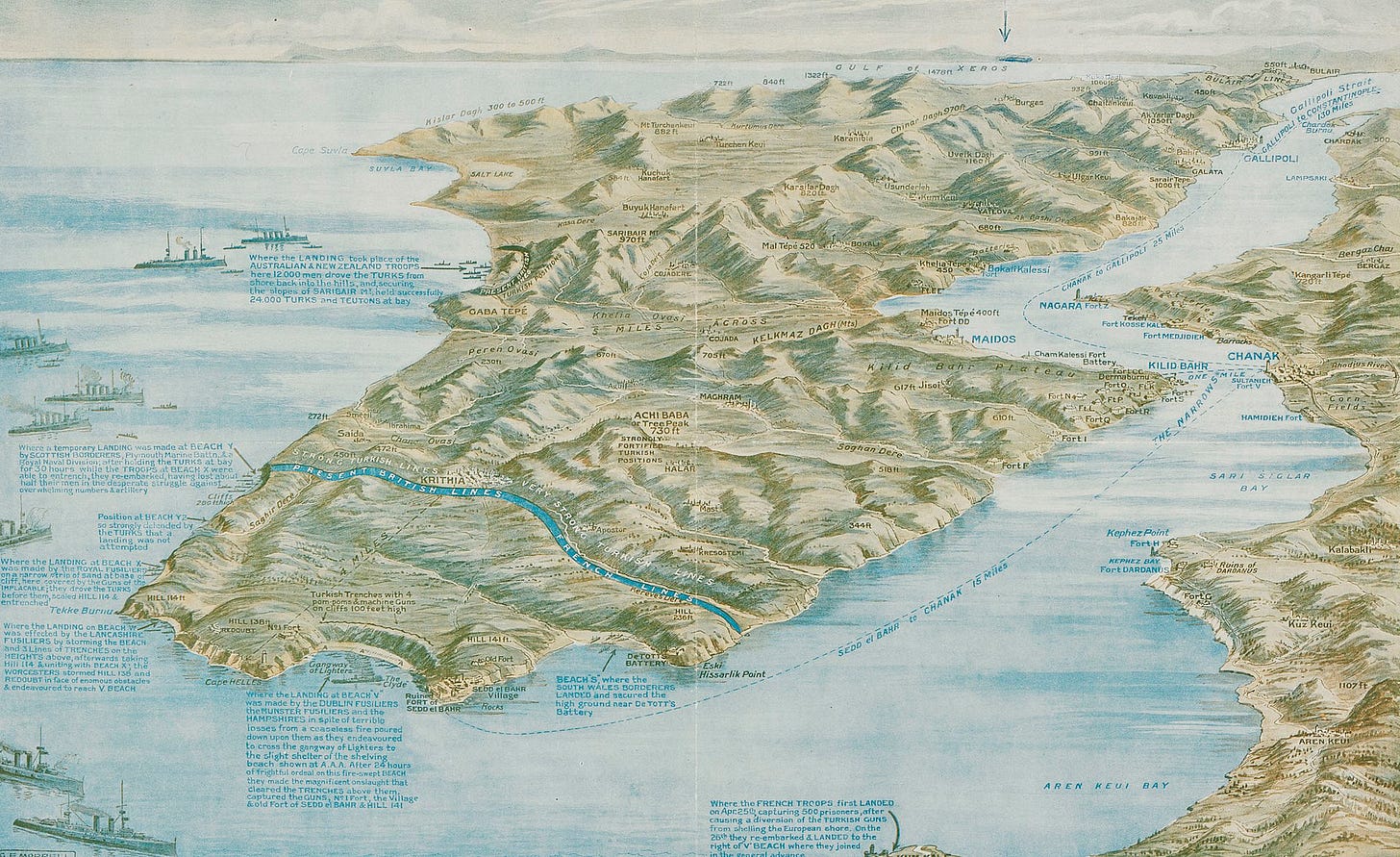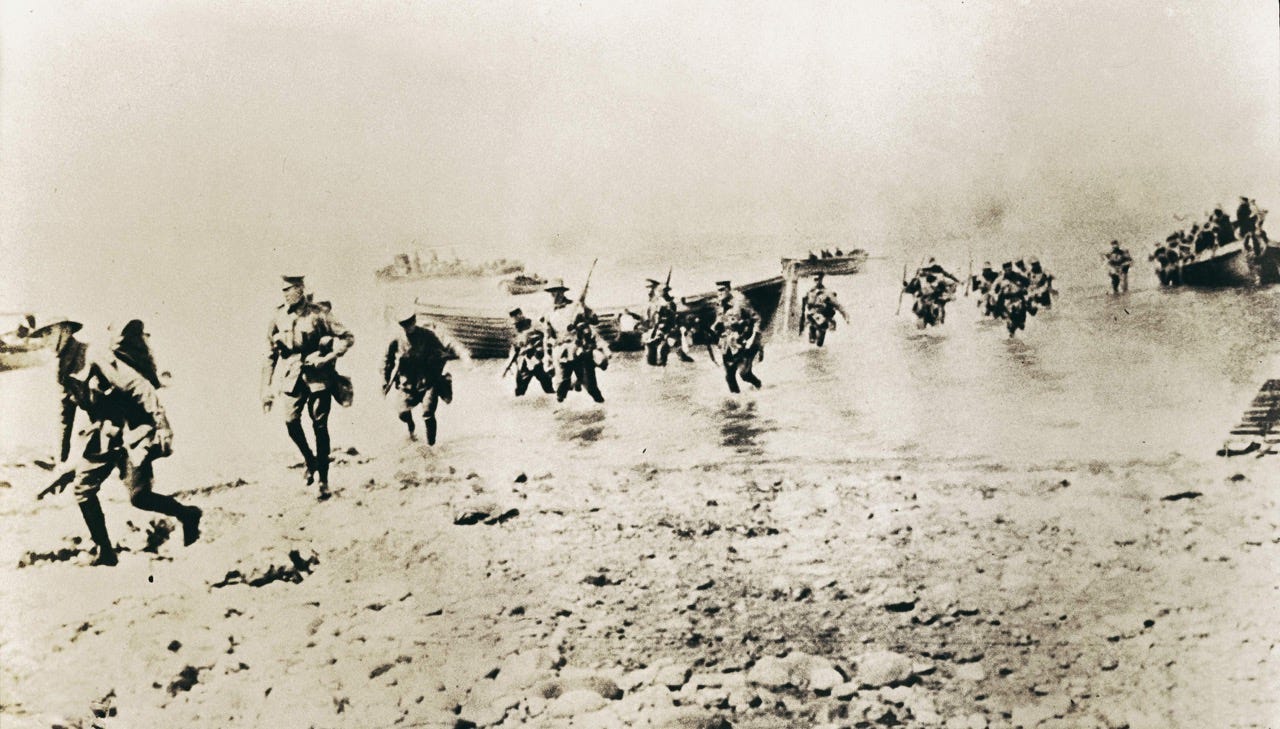The Gallipoli Campaign of 1915 ranks as one of the most controversial of the Great War, a costly gamble intended to knock Turkey out of the war and to command the main ice-free supply line to Russia through to the Black Sea ports. The land-based Gallipoli campaign evolved from a plan to 'force' a way through the narrow Dardanelles using ships alone, knocking out the fortresses commanding the straits, and ultimately threatening Constantinople – with the belief that this alone would be sufficient to drive Turkey from the conflict. A combination of factors led to the failure of this plan, most particularly the difficulty of naval artillery fire against land targets, the presence of mobile batteries on both the European and Asian shores and ineffective minesweeping by the Allies. This caused an escalation of the conflict, and a commitment to deploy troops in an invasion of the Gallipoli Peninsula, intended to neutralise the coastal batteries and minefields. This deployment was to support the naval operation, but increasingly, this aspect of the campaign became forgotten as it was prolonged, with the Navy abandoning their attempt to force the Dardanelles.
The Landing from HMT River Clyde, Gallipoli, 25 April 1915
The distinguished war correspondent, H.W. Nevinson, attended the Gallipoli campaign as he had done the Greco-Turkish War of 1897. Writing in 1918, he reviewed the what-ifs of the campaign, which emphasised what could have been gained from the enterprise:
The occupation of Constantinople would have paralysed Turkey as an ally of the Central Powers; it would have blocked their path to the Middle East, and averted danger from Egypt, the Persian Gulf, and India; it would have released the Russian forces in the Caucasus for action elsewhere; it would have secured the neutrality, if not the active co-operation of the Balkan States, and especially of Bulgaria … by securing Bulgaria’s friendship, it would have delivered Roumania from similar apprehensions along the Danube and in the Dobrudja; it would have confirmed the influence of Venizelos in Greece and saved King Constantine from military, financial and domestic temptations to Germanise; above all it would thus have secured Russia’s left flank…[1]
With the failure of the campaign, it is difficult to assess whether these claims might have been reasonable. But it is clear that, with so much at stake, the campaign has been dissected endlessly.
In early January 1915, the Secretary of State for War, Field Marshal Lord Kitchener, had himself indicated that the Dardanelles were probably the best place to stage a ‘demonstration’ in support of Russian allies. Although pledging no military support, Kitchener had engaged in discussion with the First Lord of the Admiralty, Winston Churchill, regarding the use of ships alone (Fig. 1).
Fig. 1: The defences of the Dardanelles and the outcome of the Naval Attack on 18 March 1915
In his version of events published in the 1915 volume of The World Crisis, Churchill made no bones of his enthusiasm for the naval campaign, with or without military support.
We had undertaken to begin a serious bombardment of the Dardanelles forts, and to attempt, without the aid of an army, by a new and piecemeal reduction, to fight our way slowly into the Marmora … We had undertaken this operation, not because we thought it was the ideal method of attack, but because we were told that no military force was available.
Absent from this account is the reliance on an offer from the Greeks on 27 August 1914 to engage the Ottomans in military action, providing military resources that would commit sufficient troops to take the peninsula – thereby assisting the passage of ships through the Dardanelles straits. The Greek plan was initially to land 60,000 men at Gaba Tepe, and two battalions on the Asiatic Shore at Kum Kale, in order to neutralise the gun batteries there, followed by operations to land troops at Bulair, Alexandretta and the Gulf of Adramyti intended to support and hold the beachheads. The Greek offer very soon evaporated with growing tensions in the Balkans, and the passage of the ships as a military force alone was set. Yet the likelihood of naval action by itself bringing about the required results were very slim indeed. And Lord Kitchener’s opposition to sending troops to the theatre to support them evaporated.
Battleship HMS Irresistible sinking during the attack on the Dardanelles Narrows (18 March 1915)
Once the naval bombardment of the outer defences had commenced it became clear that, despite initial claims to the contrary, there was no chance that the attack would be called off if it achieved naught. As early as 24 February 1915 the War Council recognised that commitment to the Dardanelles was now make-or-break.
If a success at the Dardanelles could win the Balkans to the entente, a failure must have the opposite effect. The opening of the bombardment had attracted such world-wide attention that, for the sake of prestige, the enterprise must be carried through, no matter what the cost.
Already, at a meeting of the War Council on 19 February 1915 – the day of the opening naval bombardment – Lord Kitchener had accepted this view and had committed his last division of British regular troops, the 29th, together with the Australian and New Zealand Army Corps (ANZAC) to supporting the campaign. From this point onwards a greater consideration of the challenges set by the geography of the Dardanelles straits and the Gallipoli Peninsula was required. General Sir Ian Hamilton, one of Britain’s most senior soldiers, was selected to command the expedition by Kitchener on 12 March 1915.
Sir Ian Hamilton (1853-1947) [photographed about 1910]
The outcome of the meeting between the two men is controversial, as it has helped define the conception of the campaign as hastily conceived and poorly executed – and thereby open to severe criticism. Hamilton himself suggested in his post-war memoir Gallipoli Diary, that his appointment with Kitchener was matter of fact, supported by the minimum of information and a peremptory treatment.
Opening the door I bade him [Kitchener] good morning and walked up to his desk where he went on writing like a graven image. After a moment, he looked up and said in a matter-of-fact tone, “We are sending a military force to support the Fleet now at the Dardanelles, and you are to have Command”.
Hamilton’s account continues with the story of a briefing by Major-General Sir Charles Callwell, Director of Military Operations, who used a map (unspecified, but most likely to be the 1908 one-inch map of the Peninsula and the Dardanelles, the only one available to the Allies at this point) to illustrate the original plan to attack the peninsula that had been worked out by the Greeks. Callwell knew all too the well the issues presented – he had been instrumental in developing a report on the defences some nine years before, in 1906. This report was not alone. There had been other appreciations constructed by both Military and Naval Intelligence, that were both available for view and known to the very general who was explaining the plan to Hamilton on that fateful afternoon – Callwell.
Research casts doubt on the long-held view that the Allied general staff had a poor understanding the nature of the terrain that they were expected to fight on, with inadequate and poorly-surveyed maps, and little aerial reconnaissance, with a mythology developed that much of the information was ‘gathered from guidebooks bought in the shops of Egyptian city of Alexandria’. This has always appeared in stark contrast to the extensive understanding and wise use of terrain by the Turkish troops, which led ultimately to their victory in the campaign, and the withdrawal of Allied troops. It has been said that terrain either dictates or influences battle – in this case, it is the former that is writ large, leading one Australian historian to comment that: ‘At virtually every stage of the campaign the advantages and limitations imposed by terrain dominated the battlefield and largely determined the outcome’.
Graphic map of the Dardanelles and Gallipoli, showing the Entente bridgeheads at Cape Helles and ANZAC Cove before the Suvla Bay landing
Appreciation of terrain, and the capability of exploiting it in the face of uncertain odds forms part of the concept of warfare as developed by the Prussian theorist Carl von Clausewitz (1780–1831), and in particular the concept of ‘friction’, originally defined by him as ‘the effects of reality on ideas and intentions in war’. ‘Friction’ can be identified as a widespread phenomenon, a concept that invests most military campaigns throughout history. As theorist Barry Watts has identified:
The diverse difficulties and impediments to the effective use of military force that those possessing military experience instinctively associate with this phrase are generally acknowledged to have played significant roles in most, if not all, the wars that have taken place since Clausewitz’s time.
One of the most significant components of what has become known as ‘General friction’ relates to the balance between intelligence and uncertainty in prosecuting a campaign, as well as the danger and exertion experienced by troops on the ground. With greater uncertainly comes greater danger; as troops are affected by these conditions, so increasing friction creates a lag that prevents the plan from being enacted to its fullest degree. With this in mind, the idea that ‘friction’ impeding the success of a campaign could be overcome by the momentum of a force of arms at Gallipoli, with men jumping from open boats, on a hostile shore, without adequate artillery, and facing the uncertainty of the unknown terrain, seems a little fanciful.
New Zealand troops landing at Gallipoli
In preparing to both prosecute landings on – and defend the terrain of – the Gallipoli Peninsula, both sides were also aware that there were a limited number of locations, determined largely by the disposition of major terrain elements, where a landing could be successfully executed. The 29th Division was sent with much reluctance by the Secretary of State for War, Lord Kitchener, to the Dardanelles. It was to be the spearhead of the campaign, sent with intention to the most heavily defended part of the southern Peninsula, while the more inexperienced ANZAC Corps were sent to the topographically challenging, but less well defended area that has since become known as Anzac.
ANZAC Cove, Gallipoli
Exhaustive discussion of the terrain intelligence resources available to Hamilton and his staff may be consulted elsewhere. Suffice to say that most of the controversy relates to the resources made available to Hamilton at or close to his briefing by Kitchener and Callwell on 12 February 1915. The material provided to Hamilton, according to the Official History, was slight:
The catalogue was not a long one. Three intelligence officers, who had left England a few days before, would, it was hoped, be able to furnish him with news of the enemy; but, for the moment, his store of knowledge consisted of Lord Kitchener’s instructions, a handbook of the Turkish army, dated 1912, a pre-war report on the Dardanelles defences, and a map which subsequently proved to be inaccurate.
Hamilton himself had claimed in his Gallipoli Diary, that he had been underserved by the General Staff:
Ten long years of General Staff…; where are your well-thought-out schemes for an amphibious attack on Constantinople? Not a sign! Braithwaite [Hamilton’s Chief of Staff] set to work in the Intelligence Branch at once. But beyond the ordinary text books those pigeon holes were drawn blank. The Dardanelles and Bosphorous might be on the moon for all the military information I have to go upon. One text book and one book of traveller’s tales don’t take long to master … There is no sense trying to make plans unless there is some sort of material, political, naval, military or geographical, to work upon.
To summarise: here we have seen that General Sir Ian Hamilton faced considerable challenges in planning to storm the beaches of Gallipoli on 25 April 1915. Although he overstated the extent of these challenges, there is no doubt – as I will demonstrate in part two – that the challenges of terrain would ultimately be insurmountable.
[1] H.W. Nevinson, The Dardanelles Campaign (London, 1918), pp. vii–viii. For further reading see Brigadier-General C.F. Aspinall-Oglander, Official History of the Great War, Military Operations, Gallipoli. Volume 1. Inception of the Campaign to May 1915 (London, 1929); P. Doyle and M.R. Bennett, ‘Military geography: the influence of terrain on the outcome of the Gallipoli Campaign, 1915’, Geographical Journal, 165 (1999), pp. 12-36; Jenny Macleod, Reconsidering Gallipoli (Manchester, 2004); P. Chasseaud and P. Doyle, Grasping Gallipoli. Terrain Intelligence, Maps and Failure at the Dardanelles, 1915 (Spellmount: Staplehurst, 2005); K. Celik and C. Koc (eds), The Gallipoli Campaign, International Perspectives 85 years on (Cannakale: Mart University, 2006).












Interesting and insightful perspective on this controversial campaign. Looking forward to part 2. Cheers! David M